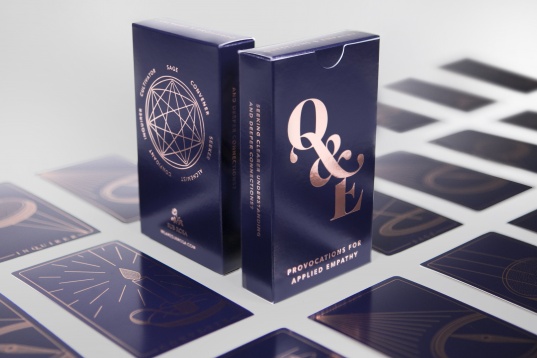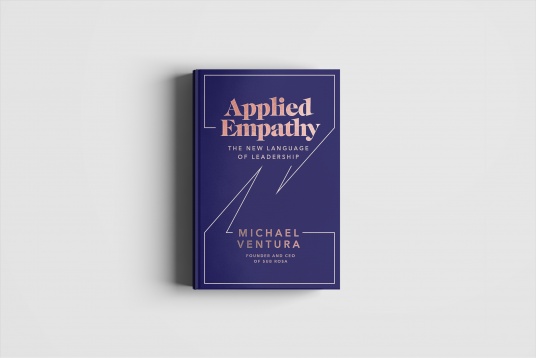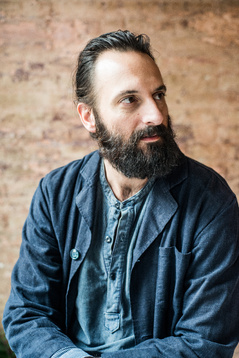I met with Michael Ventura on a quiet street in West Village, where his ecosystem lives: Sub Rosa, a strategy and design practice he founded in 2006, Calliope, the cultured home furnishings boutique he opened with his wife, And & And, an art and events gallery, and Corvus, a spiritual medicine practice. Our conversation moved seamlessly through abundantly naturally lit rooms, exposed brick walls and industrial sliding doors, passing from one idea to the next and gravitating towards the center of it all: applied empathy.
The story begins with Sub Rosa, the strategy and design practice that Michael co-founded with a friend, and which he now owns and is CEO and Chief Creative Director of. “Sub Rosa” comes from Latin and it means “in private”, or “behind closed doors”, a fitting name for an agency defined by a very unique modus operandi. Sub Rosa has empathy at the center of its business approach. Solving problems from a place of deep understanding and openness sets them apart in their work with clients such as Adobe, General Electric, Pantone, Nike to name just a few. Michael and his team teach the Applied Empathy course at Princeton, which quickly became one of the most popular courses in the curriculum. They created a beautiful empathy exploring instrument - “Questions & Empathy”, a Tarot like deck of cards which carries the user through seven archetypes, seven ways of being empathic and has the motto: “No small talk”. Every month they produce the Applied Empathy podcast, which hosts enlightening conversations on topics varying from community, creativity, gender issues, to blockchain and consumption, all viewed through an empathic lens. “Applied Empathy: The New Language of Leadership”, Michael’s long anticipated book is coming out in May, having Arianna Huffington’s endorsement because it “shows us how to unlock our ability to design solutions, spark innovation, and solve tough challenges with empathy at the center.”
How did you become interested in strategy and design, what inspired you to build Sub Rosa?
I’ve always been a problem solver and a lover of ideas. Ever since I was a little child my favorite pastime was to understand people and the problems they were trying to solve so I could help them. Strategy and design are two very versatile and powerful tools to help solve problems so I focused my areas of study in these areas.
The inspiration for Sub Rosa came quite naturally out of this desire to solve problems. I have owned my own businesses since I graduated university in 2002. Early on, I ran a digital agency with a business partner and friend. That evolved into a design studio which we ran together for about 6 years. Then, in 2009, after ending the partnership amicably, I expanded the design studio to include the strategic capabilities we have today.
Did you have a mentor along the way, someone to influence and guide you through your path? What were the key sources of support or resistance you encountered?
In truth, everyone is a mentor if you allow them to be. There are always teachable moments that we have the capacity to learn from and expand our abilities if we are willing to see them. My mentors have been those closest to me – my wife, my friends and family – as well as several spiritual teachers who I’ve worked with throughout the years.
In terms of the support or resistance, there have been an abundance of both as I’ve grown. What I can say with all sincerity is that support must start from within. Any other form of support is temporary and while it might be helpful at the time, if we cannot learn to understand and support ourselves, we cannot truly grow. As for resistance, there is an expression I’ve always liked – Pressure makes diamonds. Gentle, constant pressure is a good thing. It reminds us we are growing and expanding and if managed correctly, gives us the impetus to keep evolving.
How did you decide to bring empathy in the center of your business approach? How did the “Questions & Empathy” deck come to life?
Empathy is a fundamental aspect of our human condition. Yes, some people have more empathy than others, but we all have the capacity to be empathic. When thinking about the best work we do at Sub Rosa, it became clear that it all was grounded in empathy – our ability to step outside of our own perspective and to see the world from new eyes. This perspective became the cornerstone of our design philosophy. In many ways it is an extension of human centered design thinking, which was pioneered over 30 years ago. Human centered design is valuable, but it does leave more to be understood. Our approach, which we call Applied Empathy, pushes beyond human-centered thinking and expands to consider a multitude of inputs that help make our solutions as comprehensive and useful as possible.
Questions & Empathy is a tool we developed to help make empathy a little easier for people to grasp. I think of it like stretching before you exercise. The deck of cards is a facilitation tool that helps ask deep questions quickly – moving people from superficial small talk, to big talk.”
Was there ever a business situation when it was particularly hard to apply empathy? What happened?
Every situation has an opportunity to apply empathy. That said, some of the hardest ones are the ones that are the most personal. That’s because it is so hard for us to step outside of our own views when we are dealing with deep rooted beliefs. It’s hard to break old patterns. It’s hard to do something differently than you have always done it. It creates anxiety and tension. But that sort of work can also be the most life changing if you are brave enough to do it.
Your book, “Applied Empathy, The New Language of Leadership” is coming out in May, what do you hope people will stop or start doing after reading your book?
My hope with the book is that people will learn that empathy is not a “gift” but a skill. It’s not something to be intimidated by and it’s definitely something that can be learned. In this very volatile time in human history, our ability to understand each other and our connection to the planet are critical to our survival. I know my book is only one message in a sea of information we encounter every day, but hopefully it will help make a difference to some people.
How does a typical day at work look for you? How does your agenda look for the next months, what upcoming projects are you most excited about (besides launching your book, of course)?
So I have a few things I do every day. There are three businesses that I run at present. There’s Sub Rosa, Calliope (a furniture and design store), and Corvus (an alternative medicine practice). To me, each of these endeavors are so much a part of me and my interests.
My work day starts at 8am when I see a patient for alternative medicine work. I work with them for an hour and then head into Sub Rosa. During the day at Sub Rosa I balance my time between meetings with clients, creative and strategic workshops with our team, and my duties as CEO (vision for the business, internal management etc.). At 6:30 pm I see another patient. After that, I usually check in on the store and see how things have gone that day and respond to any emails that I haven’t gotten to.
In terms of my agenda for the months ahead, it’s always changing. I travel about 20% of the year and it’s an exciting part of my job. Lately I’ve been enjoying running more public-facing workshops with people who are interested in learning more about empathy. It’s an exciting opportunity to bring this work to so many diverse audiences – from government and military clients to corporate clients to mindfulness and wellness communities. Everyone is interested in empathy and it’s a wonderful gift to be able to share my thinking with so many diverse groups.
What is the most important aspect of your work? What are the goals you most want to accomplish - not so much the goals that are in your job description, but the goals you hold personally?
My most important aspect of my work is that I find joy in it. Life is very short and if we don’t enjoy what we’re doing, we should find something else to do. Suffering is a choice. I have worked with refugees and cancer survivors who’ve taught me this. Our mindset dictates our realities. So I guess my goal, which is always evolving, is to be happy and to spend time with people I love doing things that give us a sense of purpose.
What do you read now online (favorite sites, blogs, magazines) and offline (favorite books, magazines)? What is your favorite music, movie, work of art?
I don’t have a lot of consistency in my reading habits. Online I typically read about world events and content from the business, design, and spiritual world. The sources of these content are flexible as I believe we should never put too much stock in any one outlet. The point is to absorb a lot of different things but make our own views.
Offline I am reading 4 things right now: Taoist Shaman by Mantak Chia, The Systems View of Life by Fritjof Capra and Incognito by David Eagleman.
Musically, my tastes are very diverse but some recent artists on my playlist include Krishna Das, Greta Van Fleet, Charlie Mingus, The Stranglers and Tinariwen.
Film-wise, I’ve been watching a lot of documentaries. Basically anything about antiquity, nature, or eccentric subcultures.
My favorite piece of art, if I had to choose, would be La Sagrada Familia in Barcelona. It moves me to tears.




















